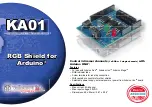i.MX51 EVK Linux Reference Manual
Freescale Semiconductor
9-1
Chapter 9
Software Based Peripheral Domain Frequency Scaling
The frequency of the clocks in the peripheral domain can be changed using the software based Bus
Frequency Scaling driver. Enabling this driver can significantly lower the power numbers in the LP
domain. Depending on the platform, the voltage of the peripheral domain can also be dropped using the
on board PMIC.
9.1
Software based Bus Frequency Scaling
The SW will automatically lower the frequency of the various clocks in the peripheral domain based on
which drivers are active (it is assumed that the drivers will use the clock API to enable/disable their
clocks). Two setpoints are defined for the peripheral bus clock:
AHB_HIGH_SET_POINT - The module requires the AHB clock to be at the highest
frequency (133MHz).
AHB_MED_SET_POINT - The module requires the AHB clock be above 66.5MHz.
The Bus Frequency Scaling driver will take into account the above two associations for the various clocks
in the system before changing the peripheral clock.
To enable the SW based Bus Frequency Scaling
(
not needed to enter LPAPM mode
)
use this command:
echo 1 > /sys/devices/platform/busfreq.0/enable
To disable the SW based Bus Frequency Scaling use this command:
echo 0 > /sys/devices/platform/busfreq.0/enable
Based on which clocks are active, the system can be in any of the three modes specified below:
9.1.1
Low Power Audio Playback Mode (LPAPM)
When all the clocks that need either of the above two mentioned setpoints are disabled, the system can
enter an ultra low power mode where the AHB clock and other main clocks in the LP domain are dropped
down to 24MHz. On certain platforms and depending on the type of memory used, the DDR frequency is
also dropped down to 24MHz. This mode is most commonly entered when the system is idle and the
display is turned off. The implementation automatically detects when this mode can be entered and calls
into the Bus Frequency driver to change the clocks (and voltages if it can be done) appropriately. On
certain platforms, the entire SoC is clocked off the 24MHz oscillator and all PLLs are turned off to save
more power.
If any driver that needs the higher AHB clock enables its clock, LPAPM mode will be exited.
Entry and
exit from the LPAPM mode does not require the Bus Frequency Scaling driver to be enabled.
Summary of Contents for i.MX51 EVK
Page 1: ...Part Number 924 76374 Rev 10 11 01 11 2010 i MX51 EVK Linux Reference Manual...
Page 14: ...i MX51 EVK Linux Reference Manual xiv Freescale Semiconductor...
Page 18: ...i MX51 EVK Linux Reference Manual xviii Freescale Semiconductor...
Page 24: ...i MX51 EVK Linux Reference Manual xxiv Freescale Semiconductor...
Page 38: ...Machine Specific Layer MSL i MX51 EVK Linux Reference Manual 2 8 Freescale Semiconductor...
Page 52: ...MC13892 Digitizer Driver i MX51 EVK Linux Reference Manual 5 4 Freescale Semiconductor...
Page 64: ...TV Encoder TVE Driver i MX51 EVK Linux Reference Manual 10 4 Freescale Semiconductor...
Page 82: ...Video for Linux Two V4L2 Driver i MX51 EVK Linux Reference Manual 12 8 Freescale Semiconductor...
Page 86: ...i MX5 Dual Display i MX51 EVK Linux Reference Manual 13 4 Freescale Semiconductor...
Page 100: ...X Windows Acceleration i MX51 EVK Linux Reference Manual 16 6 Freescale Semiconductor...
Page 118: ...Low Level Keypad Driver i MX51 EVK Linux Reference Manual 20 6 Freescale Semiconductor...
Page 134: ...Security Drivers i MX51 EVK Linux Reference Manual 22 10 Freescale Semiconductor...
Page 148: ...Inter IC I2C Driver i MX51 EVK Linux Reference Manual 24 4 Freescale Semiconductor...
Page 178: ...ARC USB Driver i MX51 EVK Linux Reference Manual 29 10 Freescale Semiconductor...
Page 194: ...OProfile i MX51 EVK Linux Reference Manual 33 6 Freescale Semiconductor...

















